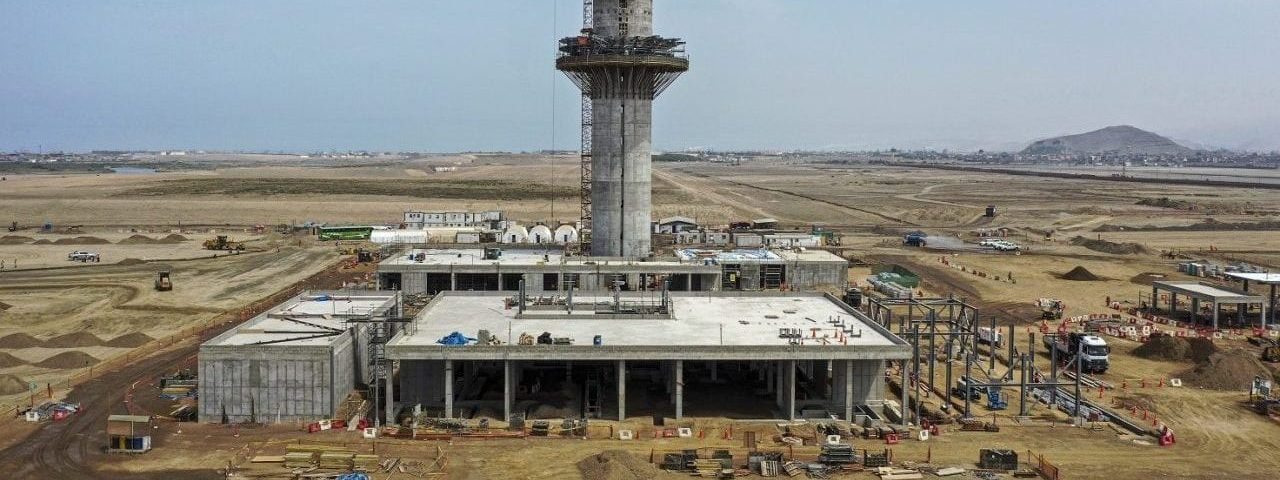
How We Ensure the Electricity Supply in an Airport's Control Tower
30 of April of 2021
The control tower is a crucial part of an airport. Without it, critical services that are essential for air traffic control and aircraft management in the airfield would cease to function: aeronautical monitoring and control systems, radars, and the beacon lights that guarantee proper performance of fundamental airport operating systems.
To ensure that the tower is operational 24 hours a day, 365 days a year, it must have an electrical power supply system that ensures operation despite any contingency, a system that has an alternative way of guaranteeing continuous power supply in the event of a failure. One good example is the system that Ferrovial Construction is building and installing in the new control tower at the Jorge Chávez Airport in Lima.
Medium voltage rings to ensure redundancy
Operating electrical systems for airport control towers is based on redundancy. Its different parts and elements overlap so that if something fails, there is always a continuous supply with no interruptions.
This principle of redundancy is in place to ensure that power reaches the control tower from outside supply points. The electrical supply from substations first reaches medium voltage rings. These transport it to input cells and transformers that convert it into low voltage energy. That energy subsequently feeds all of the tower’s equipment.
With their ring shape, these loops the passage of energy to continue on one side if it is interrupted on the other – which is very unusual.
There is also a redundancy at the medium voltage input cells and medium to low voltage transformers (MV/LV). This ensures that the system continues to operate if a piece of equipment breaks down or needs maintenance.
Low voltage redundancy
Now at low voltage (LV), another backup system of main and secondary panels and wiring through independent paths is once again deployed. This duplication ensures that the supply reaches each and every one of the devices and systems in the control tower.
To guarantee greater redundancy in the electrical supply, there are redundant generator sets (2x) with an individual capacity that can provide the necessary total load.
That way, if one side of the ring breaks, the medium voltage supply is ensured on the other side of the ring. If any of the cell or transformer equipment breaks down, there is a second option, as these setups offer redundancy. If one of the main and/or secondary panels stops working, its twin remains operational. In the extreme event that the tower runs out of external power, it would also have the two generators as mentioned previously, and the electrical system also has UPS systems for critical elements. All of this ensures that the control tower’s activity never stops due to an electrical failure.
The rules governing criticality
These electrical safety systems are common in airport control towers around the world, and they’re shaped by the standards of the International Air Transport Association (IATA). Their complexity is linked to the criticality and importance of the control towers.
Airports’ primary function depends on these towers. The professionals who work there are in charge of organizing the orderly arrival and departures of planes and monitoring the entire airfield. The electricity supply is essential to ensuring its operation.
Losing power in a control tower would mean having to close the airport. Computers, servers, radars, fire systems, and beacon lights would all go dark. This would lead to numerous problems: diverted flights, disgruntled travelers, and the resulting financial consequences.
In other parts of the airport, temporarily losing access to electricity would not be so serious. Take, for instance, ticket counters: if some stopped working, long lines would form and there would be delays, but the airport could continue to operate. However, without beacon lights on the runway, planes wouldn’t be able to land at night. Without the computer systems used by air traffic controllers, it would be absolutely impossible to control air traffic.
Our work guarantees that the control tower at the Lima airport won’t face any problems due to the electricity supply. It has to be operational at all times to monitor the airfield and provide service for the planes taking off and landing in the Latin American capital.
The challenges of installing this electrical layout
As is always the case when working on projects for airports, this project has not gone without its challenges. First of all, there is the fact that this is a construction-only project. The design was given to us, and this entails significant effort to define and clarify numerous details needed for construction.
The already demanding project schedule took on the additional challenges of working remotely under the restrictions of the COVID-19 pandemic. Our team came across the difficulties, as did contractors, manufacturers, and transporters in carrying out their work and meeting the set deadlines.
The time difference and people from different cultures working together also added some complexity to the project. Generally speaking, we can say that installing this electrical system for the new control tower at the Jorge Chávez Airport in Lima is challenging. However, thanks to our teams’ efforts, it is expected to be completed in the first two quarters of 2022. It will then be ready to ensure that planes continue to take off and land in Lima, Peru’s international gateway.





There are no comments yet